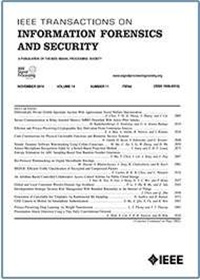Feature Reconstruction: Far Field EM Side-Channel Attacks in Complex Environment
IF 8
1区 计算机科学
Q1 COMPUTER SCIENCE, THEORY & METHODS
IEEE Transactions on Information Forensics and Security
Pub Date : 2025-09-18
DOI:10.1109/TIFS.2025.3611788
引用次数: 0
Abstract
Far Field EM Side-Channel Attacks (FEM-SCAs) have emerged as a realistic security threat to widely deployed RF-integrated IoT edge devices. In mixed-signal chips, side-channel leakage may unintentionally couple with transmission signals and be emitted via the on-chip antenna, potentially allowing adversaries to extract sensitive information from the victim at long distances. However, in practical scenarios, far field EM traces captured at long distances usually suffer from noise and interference, which makes the attack less efficient or sometimes even unfeasible. In this paper, we propose a Domain-Adversarial ReFeature Nueral Network (DAR-NN) to facilitate “noisy-clean” adaptation for far field EM traces captured at long distances. By integrating a DAE model with two deep-learning classifiers as regularization terms, the proposed DAR-NN model can reconstruct features of traces obtained remotely in complex environments, thereby achieving a more efficient FEM-SCA. We first test our model by using a publicly available dataset and show that it is feasible to extract the AES key from 141 traces captured at 15 m distance to the victim, which is 58.7% more efficient than existing methods with 80% less profiling data. Afterwards, we set up a more complex experimental environment with a HackRF radio serving as an interference source. We show that the proposed model can still extract the key by using around 2K traces at 15 m even in the presence of 25% active interference, while the state-of-the-art model fails under same conditions.特征重构:复杂环境下远场电磁侧信道攻击
远场电磁侧信道攻击(fem - sca)已经成为广泛部署的射频集成物联网边缘设备的现实安全威胁。在混合信号芯片中,侧信道泄漏可能会无意中与传输信号耦合,并通过片上天线发射,这可能会让攻击者从远距离受害者那里获取敏感信息。然而,在实际情况中,远距离捕获的远场电磁走线通常会受到噪声和干扰的影响,这使得攻击效率降低,有时甚至无法实现。在本文中,我们提出了一种域对抗重构神经网络(DAR-NN),以促进远距离捕获的远场电磁迹线的“噪声清洁”适应。通过将DAE模型与两个深度学习分类器作为正则化项进行集成,所提出的DAR-NN模型可以重建在复杂环境中远程获得的轨迹特征,从而实现更高效的FEM-SCA。我们首先通过使用公开可用的数据集测试我们的模型,并表明从距离受害者15米的141条轨迹中提取AES密钥是可行的,这比现有方法效率高58.7%,分析数据减少80%。之后,我们设置了一个更复杂的实验环境,用HackRF无线电作为干扰源。我们表明,即使在存在25%有源干扰的情况下,所提出的模型仍然可以在15米处使用约2K走线提取密钥,而最先进的模型在相同条件下失败。
本文章由计算机程序翻译,如有差异,请以英文原文为准。
求助全文
约1分钟内获得全文
求助全文
来源期刊

IEEE Transactions on Information Forensics and Security
工程技术-工程:电子与电气
CiteScore
14.40
自引率
7.40%
发文量
234
审稿时长
6.5 months
期刊介绍:
The IEEE Transactions on Information Forensics and Security covers the sciences, technologies, and applications relating to information forensics, information security, biometrics, surveillance and systems applications that incorporate these features
 求助内容:
求助内容: 应助结果提醒方式:
应助结果提醒方式:


